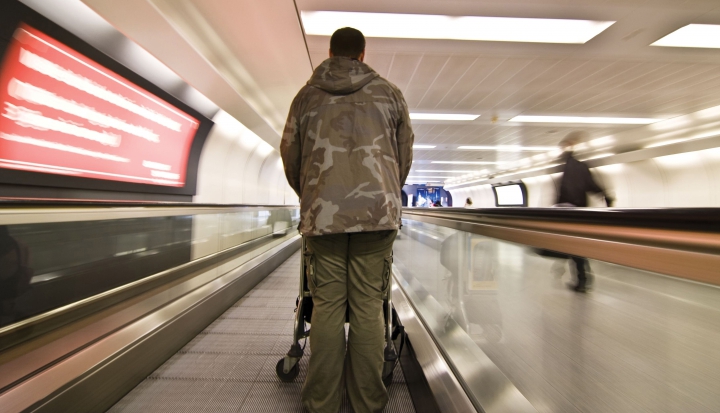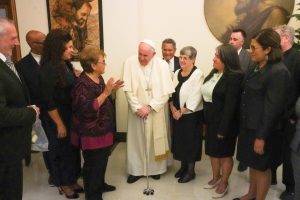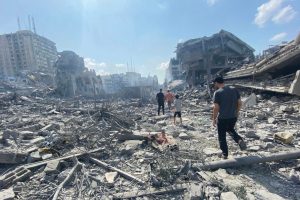It’s an uphill battle for returning veterans as they look for support from their church and their community.
For more on support for vets, read On the homefront: What’s for dinner?
Coming home still shimmers in Father Vincent Manuel’s memory. When he returned from Iraq in 2005, Manuel’s flight landed at the Dallas-Fort Worth Airport, where he and the soldiers on board were greeted by water cannons showering the plane. Some laughed at the baptism, others wiped away tears.
Inside the airport they were met by a jubilant crowd. People cheered, waved, pumped “Welcome home!” signs, and jumped over the ribbon to hug the homebound men and women. “I was so touched by that welcome,” says Manuel, a chaplain at Fort Carson Army Base in Colorado Springs, Colorado.
The greeting, he says in his careful, lilting Indian accent, was enough for him. “It helped me get past my own loneliness and fears,” he says. “But for soldiers, especially those who have had many deployments, I think that welcome isn’t enough.”
Catholic dioceses and parishes across the country are examining how they can better reach out to veterans, their families, and also to active National Guard volunteers and reservists awaiting their next deployment. About 2.3 million Americans have served in uniform in Iraq and Afghanistan. A quarter of that number are Catholic, about 575,000 men and women.
“Many of these soldiers have grave wounds, some of them invisible wounds,” Manuel says. “These are individuals who have paid a heavy price for our freedom. Until they are healed, we need to keep affirming our gratitude . . . but their numbers, the sheer numbers. I have concern that individual soldiers will become lost.”
The effect of combat on an individual soldier can be unpredictable. Logan Mehl-Laituri realized, while serving as a light infantry soldier in Iraq, that he was a pacifist. “God was also with the people on the other side of my rifle scope,” he says. “That’s a different kind of God than a God who is helping you pull the trigger.”
Mehl-Laituri, now a student at Duke University, says he’s found that civilians still let stereotypes get in the way of relating to him. “As a combat soldier, I’m honorable and virtuous. But as a vet I’m [supposedly] angry and prone to violence. For many pacifists in churches, the military is bad because war is bad. You’re the embodiment of that in the world.”
Brian Moyer, a veteran who served with the Oregon National Guard, experienced the dizzying confusion of a second deployment. “You come home and start normalizing your experiences, and then you’re forced to go back,” he says. “That’s different from earlier wars. It starts getting really hard.”
“When Brian came back from his second tour in Iraq, he was changed,” says his mother, Connie Moyer.
After his first tour in Iraq, Moyer spent two years at Mount Angel Seminary in St. Benedict, Oregon. His mother believes those two years saved him. “We wished everyone who came back from war could spend that time to heal,” she says. “My daily prayer is that God bless them and bring them back safe in mind, body, and spirit.”
Her words point to a new understanding about war’s scars: In addition to physical, mental, and emotional injuries, many veterans and their loved ones and supporters are now beginning to better understand “moral injury,” described as a wound or corrosion of the soul.
In fact, far more veterans of Iraq and Afghanistan have been lost since coming home than have died in combat. Their suicides are a silent carnage: 18 every day; 6,500 a year. Yet their faces and names are rarely memorialized on the evening news.
Clay Hunt, a Marine who was deployed to Fallujah, Iraq in 2007 and to Helmand province in Afghanistan in 2008, was a rare exception: a Purple Heart recipient suffering from post-traumatic stress whom people did read about. Hunt, who had appeared in a suicide prevention campaign urging veterans considering suicide to reach out for help, took his own life in 2011. “Let us learn a hard lesson from this,” his best friend blogged afterward, “that some of us are still fighting the war, even though we’re home and out of uniform.”
Knowing how to support veterans is more important today than at any time since the 1970s, when the United States failed to embrace the 2.7 million Americans who served in uniform in Vietnam. “We did a terrible thing to our veterans then,” says Dr. Kathy Platoni, an Army Reserve colonel and psychologist who has served four tours in Iraq, Afghanistan, and Guantanamo.
Different wars
Soldiers have to deal with issues that most of us never confront, says Dr. James Boehnlein, a psychiatrist and post-traumatic stress specialist at Oregon Health and Science University. That may include killing someone or witnessing violence toward civilians, including women and children, theoretically excluded as combatants in the past. “They may have had to make a split-second decision whether or not to shoot someone who is possibly threatening their unit—even if that threat is a child,” says Boehnlein. “And what if they get it wrong?”
“You go to war . . . and the first thing you learn is that you’re liable to kill people,” says Mehl-Laituri. “Nowhere else in society are you expected to kill people. And in modern combat, there’s no way to tell the good guys from the bad guys.”
Dave Grossman, author of On Killing: The Psychological Cost of Learning to Kill in War and Society (Back Bay Books), found that only 15 to 20 percent, or perhaps even fewer, of World War II soldiers shot their weapons to kill. Grossman, a retired lieutenant colonel and former psychology professor at West Point, describes how the Army used behavioral training techniques, particularly with pop-up targets shaped like people, to raise that rate to 55 percent of soldiers shooting to kill in Korea; 90 percent in Vietnam; and close to 100 percent in Iraq and Afghanistan.
Common sense says those numbers mean a greater need for today’s Catholic soldiers to be able to talk with a priest. The number of U.S. chaplains, however, has collapsed.
Moyer first landed in Iraq the week before Easter and found no priest. “It was the only Easter Sunday in my life that I wasn’t able to go to Mass,” he says.
There were 3,200 Catholic chaplains serving Catholic soldiers in World War II. Today, Manuel is one of only 232 active-duty military chaplain priests with the Archdiocese for the Military Services. (Catholic chaplains in the military and at veterans’ facilities are required to be priests.) They minister to 275,000 active-duty Catholics at 220 military installations in 29 countries, plus their families, some 800,000 spouses and children.
“If you really want to know what will support Catholic veterans, it’s getting Catholic priests in the military,” Moyer says. “Start that care while they’re in combat, not after they get home. I’m very respectful of the bishops; I understand the pinch that they’re in, but the care of the soul, keeping soldiers away from temptation, their being able to receive the sacraments regularly—that’s the No. 1 thing, to get holy men into the Archdiocese for the Military.”
Another difference: Women now make up 12 percent of those serving in Iraq and Afghanistan. A shocking number of those women, 19,000 in 2010 alone by the Defense Department’s estimate, were victims of sexual assault and rape. These crimes desecrate their sense of camaraderie in the field and complicate their care when they return home because of the additional trauma and betrayal experienced beyond physical, spiritual, or other emotional injuries.
The Pentagon’s reaction has been a further betrayal. Only 8 percent of reported, investigated cases of sexual assault are prosecuted (compared to about 40 percent in the civilian world). The Pentagon has admitted the problem, even acknowledging that the 3,191 military sexual assaults reported in 2011 come nowhere close to the true numbers—which are probably closer to 19,000.
Coming home wounded
In this new millennium’s wars, far fewer American soldiers have died—6,588 out of 2.3 million as of September 2012 in Afghanistan and Iraq, versus 58,148 out of 2.7 million in Vietnam. A much larger percentage of the post-9/11 veterans, however, have needed treatment for their injuries: 26 percent compared with about 14 percent of all veterans.
The Iraq and Afghanistan Veterans of America organization reports that on any given night, about 154,000 veterans are homeless. Post-9/11 veterans already make up nearly 2 percent of that number. Complicating their assistance, at least 45 percent of homeless veterans suffer from one or more psychological illnesses, and 70 percent are self-medicating with drugs and alcohol. The Veterans Administration mental health budget has doubled to about $4 billion since 2001; even so, that number falls well short of what the need is estimated to be—up to $6.2 billion.
The pervasiveness of traumatic brain injuries and multiple deployments is also new.
“Blasts caused by explosions can cause injury even if the soldier didn’t hit their head on something or black out,” says Boehnlein. “There’s a complex gray area of trauma from blast injury mixed with psychological or emotional injury that can cause headaches, sleep disturbance, and other symptoms of post-traumatic stress. People tend to self-medicate, and drugs and alcohol make the problems worse.”
Nearly half of the post-9/11 veterans say they’ve had frequent outbursts of anger, and nearly half have experienced family stress since returning. Thirty-seven percent say they’ve experienced symptoms of post-traumatic stress, compared to 16 percent of pre-9/11 veterans.
“No one gets out unscathed,” says Platoni, the Army psychologist who includes herself in that number. “It’s what you do with it,” she says, listing family, fellow soldiers, chaplains, faith communities, and mental health professionals as being key in healing and making the transition from war to civilian life.
“Here in Oregon, we have a high percentage of soldiers who were part of the National Guard,” says Boehnlein. “A lot of soldiers didn’t know that they’d be deployed to a combat zone and weren’t as mentally prepared.”
Filling the void
Jason Hansman, director of member services with Iraq and Afghanistan Veterans of America, says that veterans frequently turn to faith-based communities, which the vets see as honest brokers of assistance. “Churches need to be more proactive about educating themselves about the issues vets face when they come home,” Hansman says. “No one expects pastors to cure post-traumatic stress. But they’re gatekeepers, pointing people in the right direction.”
A 2011 Pew survey found that faith (as measured by attendance at Mass or other services) strongly increases the chances that a veteran will readjust more easily to civilian life. That finding makes even more troubling the fact that the Catholic Church is playing catch-up in regard to outreach to veterans.
Dennis McCormack, who retired in 2009 after 26 years in the Army in order to volunteer full-time with veterans in Colorado Springs and who now serves on a diocesan committee for outreach to veterans, believes it’s time for parishes and dioceses to get more involved. “There’s already an active ministry partnership in [Colorado] Springs, with major events, guest speakers, where all these various churches were showing up to showcase their programs,” he says. “The Catholic Church was conspicuously absent.”
Colorado Springs boasts Catholic Charities’ Marian House soup kitchen and other Catholic services. The diocese also directs veterans to such resources as the Crawford House, an emergency shelter for vets; transitional housing for vets as they’re completing college degrees; and veterans courts, where vets convicted of felonies can avoid jail time with intense mentoring.
Still, McCormack sees a general dearth of outreach at the diocesan level both in Colorado Springs and across the nation. “There’s going to be people who argue with that, but we’ve called around, we’ve done that survey,” he says.
War stories
Reaching out to veterans begins with listening. What soldiers experienced in Iraq and Afghanistan is individual and yet universal: You don’t understand war if you haven’t been there, they all agree.
“Veterans are losing faith because the church doesn’t want to listen when they come home,” says Mehl-Laituri. “A lot of them lose faith because faith fails tremendously in the face of combat.”
Mehl-Laituri explains that while the military prepares soldiers to be good marksmen, there’s no effort to make moral sense of what they’ll be doing—killing people. What about loving your enemies, Mehl-Laituri wonders. “What does it mean to be a Christian soldier?”
“If you want to minister to veterans, you need to know who they are and what they’re going through,” says Manuel. “Some are wondering if what they did as a soldier was right or wrong. There are good ministry opportunities to help them share their war stories in a way that can be healing.”
Chief Warrant Officer Tony Haiduk, a career soldier, says he felt closer to God in Iraq and Afghanistan than he does in Colorado; he spent far more hours in prayer then than he does now. “I believe when it’s your time to go, well, that’s your time,” he says. “Now if you ask me if I’m afraid of dying—yeah. I am. I want to spend time with my wife and kids and my grandkids.”
“Some soldiers’ faith was strengthened, some broken,” says Manuel. “That’s no fiction.”
How Vietnam veterans were treated comes up again in regard to post-9/11 vets. The Vietnam veterans have been resolute that this generation of soldiers not be rejected as they were. Surveys suggest most Americans feel the same way, wanting to better support veterans now.
Moyer, in Portland, Oregon, sounds angry about even the accepted trope, “I support the troops but not the war.”
“I know so many people who say that,” Moyer says. “Really, you support the troops? How do you think the soldiers feel when they hear someone say the war’s evil? Intrinsically evil? What burns me as a Catholic is that some people can get so adamant against the war. And how many babies die each month from abortion?”
His objection leaves Catholics who heard Pope John Paul II’s admonition that the U.S. invasion of Iraq did not meet the standards of a just war with just one option: listening.
Yet soldiers also find themselves questioning the mission, says Mehl-Laituri, who was in Iraq from 2004 to 2005. “We were there to search for weapons of mass destruction and to win hearts and minds,” he says. “During the time I was there, I could see a change in the demeanor of the Iraqis. Their smiles became forced, the waves became obligatory. Everyone has a desire to see good in what they’re doing. In Iraq there was the knowing that part of what you were doing was counterproductive to the rest of what you were doing.”
Mehl-Laituri is angry that the bishops didn’t speak out more strongly before the war. “Silence isn’t an option, it’s a betrayal,” he says. “I hope God will have mercy on the religious leaders who were silent. I pray it every Sunday.”
Moyer’s younger brother Todd is now in Afghanistan. Connie Moyer says while neither of her sons questioned the wars, she has met veterans who have come back and said they felt lied to. “They’re very bitter,” she says.
Varying support
The cost of outreach and help for the most severely injured veterans, including men and women who are homeless and often mentally ill, is a costly, continuing proposition. Tony Haiduk isn’t sure that the country will continue funding care for veterans once the war fades from memory, but he hopes that Catholics and other Americans will prove him wrong by supporting proper funding. The IAVA spends much of its lobbying energy reminding Congress that the Veterans Administration cannot adequately reach out to troubled veterans or care for veterans without adequate funding, and that there shouldn’t be term limits on caring for veterans—many of whom will need assistance for the rest of their lives.
That’s an expensive reality of war, usually forgotten in the calculations of cost before soldiers are sent into battle.
Pushing our elected leaders to adequately fund veterans’ care is only part of what Catholics, parishes, and dioceses can do, though.
In Colorado Springs and other military towns across the country, programs to help veterans are offered on bases, through nonprofits in the community, and at churches. These programs know exactly what resources can help which veteran with what challenge.
Dennis McCormack urges parishes and dioceses in these areas to work with successful programs already established—especially in the case of complex issues such as homelessness, which McCormack thinks Catholics can address more effectively as concerned citizens rather than as well-meaning but under-equipped individuals, parishes, or even dioceses.
Help is less visible in areas without military bases. National Guard armories can be a good resource, as are Veteran Administration hospitals, and again, nonprofits and churches.
Sacred Heart in Medford, Oregon, the Moyers’ parish, has a wall with photos of parishioners who are serving, and the parish prays for their safety. “But for the veterans, there’s not much help for them,” Connie Moyer says. “We need to do more.”
Without the veterans’ pictures also on the wall, parishioners and parish staff at large parishes won’t even recognize a fellow parishioner as a vet.
“Every parish should do something to welcome veterans home,” says Dr. Platoni. “Visit them at home, ask them what they need. Don’t just express appreciation.”
At Boehnlein’s parish, St. Thomas More in Portland, longtime pastor Father Rick Sirianni served several tours with the National Guard. Sirianni has preached many homilies over the years on veterans. The parish prays for veterans in the prayers of the faithful, including prayers to support those who have physical, mental, or spiritual injuries from wars. “It’s not something that should have stigma or should be ignored,” says Boehnlein. “The church as a source of healing and the forgiveness of sins are important parts of Catholicism.”
Boehnlein’s patients have often come to believe that God has forgiven them for far-away, split-second decisions they now relive, again and again, in the dark of night at home. “It takes longer for them to forgive themselves,” he says. “That comes from a complex mixture of self-forgiveness, community forgiveness, and feeling God’s forgiveness.”
This article appeared on the November 2012 issue of U.S. Catholic (Vol. 77, No. 11, pages 16-21).
Image: Joseas Reyes/123RF.com














Add comment